Author: info@discoverdairy.com
Meet Eva: Bus Driver From Southwest Ohio Who Adopted a Cow for Her Bus
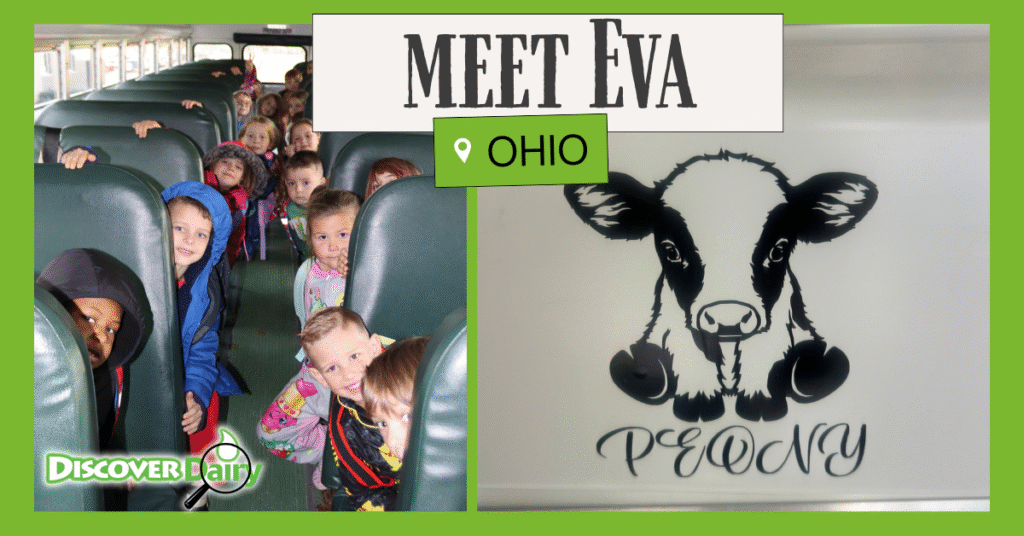
This story is part of a series of “meet & greets” with individuals who use our Adopt a Cow program to inspire you with the endless ways you can incorporate the program in the classroom and beyond!
Eva Cundiff, a bus driver for West Carrollton City Schools in Southwest Ohio, has multiple bus routes and everyone from preschoolers to twelfth-graders on her bus in a given week. So, how does she engage students that she might only see for a few minutes a day?

“I’ve been a bus driver since 1995. Through the years of driving, things have changed. Your normal home life in 1995 is nowhere near what it is now. The money’s not there for food. In our district, we’re fortunate that every child gets free breakfast and free lunch. But our kids need structure. So if I can help one kid smile in a day, I’m going to do it,” she shared.
By providing this structure and a friendly face, she hopes it makes her bus a fun and inviting place for students. Eva also describes it as a “mobile classroom,” where she can make meaningful connections and learning moments with students. That’s what inspired her to try out Discover Dairy’s “Adopt a Cow” program for her bus.
“During the summer, I typically give out ice cream or different things. I also have a newer bus that has Bluetooth, so I create playlists and the kids all enjoy singing songs and having a great time. Anytime I take a group of kids on a field trip, I always try and go in with them, too. With my bus already being kind of like a mobile classroom, I thought we could adopt a cow and try to gear it towards the bus.”
To display the adopted cow prominently on her bus, Eva decided to get a personalized decal with their calf, Peony, so the kids could see her every day. She also offered the program’s coloring sheets to her students as a take-home activity and shared dairy snacks like cheese sticks and yogurt pouches. Eva also thought outside the box when it came to group activities like butter-making – and how she could make them work in a bus setting.
“I wanted to get heavy cream, put it in a plastic container with a lid, let the kids pass it around on the bus, and take turns shaking it the whole time we’re driving to see if they can see it start clumping up to make butter,” Eva shared. “That way, everybody gets to do something. I’d have it finished up by the end of the day when they come back on the bus in the afternoon and they would get to see that it did turn into butter.”

With many of her students coming from low-income backgrounds, Eva finds it important to teach students where their food comes from and help address food insecurity in a small way.
“I think it’s important to teach students these lessons, especially because of the fact that food is so expensive and not every family has access to it. If they’re learning where it comes from, maybe they might think about what they could do when they grow up and help feed their family,” she added.
Eva has also used the limited time she has with students each day, and the material provided through the Adopt a Cow program, to teach important lessons about nutrition and the world.
“My kids know how to sit and behave because I have expectations for them to keep them safe. I figure while I’ve got their attention and I can mold their minds, why not start instilling ideas about healthy choices? We need to look out for healthy foods to keep our bones strong,” Eva shared.
The Adopt a Cow Program is now open for enrollment for the 2025 school year! Click here to learn more and adopt a cow for your classroom today. The program, which impacted more than 1.7 million students last school year, is free thanks to support from Discover Dairy partners and donors.
Discover Dairy is an educational series managed by the Center for Dairy Excellence Foundation of Pennsylvania in partnership with American Dairy Association Northeast, American Dairy Association Indiana, Midwest Dairy, The Dairy Alliance, Dairy Farmers of Wisconsin, Dairy Management West, Dairy West, New England Dairy, Dairy Farmers of Washington, American Dairy Association Mideast, Dairy Council of Florida, United Dairy Industry of Michigan, Maine Dairy and Nutrition Council, and Oregon Dairy Council.
Meet Naomi: Fifth-Grade Special Education Teacher in Connecticut

This story is part of a series of “meet & greets” with individuals who use our Adopt a Cow program to inspire you with the endless ways you can incorporate the program in the classroom and beyond!
Naomi Niemann may have grown up on a dairy farm, but not all of her students are familiar with what farmers actually do and where their food comes. Naomi decided to sign up for Discover Dairy’s Adopt a Cow program and introduce some of these concepts to her fifth-grade special education students in Mansfield, Connecticut.
“I grew up on a dairy farm when I was a child, so I naturally just love cows. I saw the program and I thought, what a fun way to bring some engagement material to students and have a cow they can follow along with,” she shared. “I work with students of lower socioeconomic status given my position. They don’t have a lot of exposure to where their food comes from, and I think that’s essential as we grow. Where do our things come from and how do we get these things? That’s a big focus of what I instructed on [with the Adopt a Cow program].”
After being paired with Oakridge Dairy, a dairy farm about 30 minutes away from most of her students, Naomi was able to spark community connections with her classroom.
“The kids were really excited when they realized that because our farm was fairly close, they have actually seen the products from the farm in the stores around us,” she added.
The Adopt a Cow program not only provides regular updates about their adopted calf and host farm throughout the year, but it has several lessons, videos and activities that bring careers in agriculture to life for students.
“Some of the materials that were given were really helpful in looking at different jobs around the farm. We do a lot of career exploration, so we could do investigatory research on those agriculture career paths and what kind of education people need,” Naomi shared.

When it came to specific subject areas, the Adopt a Cow program helped Naomi strengthen some of the math lessons she was teaching. For example, as her students learned about the different breeds of dairy cows, they were able to practice comparing and contrasting skills. When they chatted directly with dairy farmers, she says they were able to learn more about data prediction.
“I took some of the items from the program and aligned them with the content and targeted skills we were working on. When we asked our farmers questions, we used their answers to help us make more accurate, data-driven predictions,” she explained. “When our calf was three months old, our media specialist made a life-size cow for us along with a pasture for her on one of our movable bulletin boards. The kids could get the tape measure out and mark her growth on the growth chart [that the program provided]. One student was working on linear graphs and prediction, while others tried to make the measurements. The key was, the cow helped promote students’ engagement with those subject areas.”
Overall, the anticipation for their adopted calf’s updates and how fast she was growing kept Naomi’s students engaged and excited all year long.
“The kids really loved getting the calf updates. If I delayed [sharing] the cow update for a day or two, they would get really disappointed with me. So it definitely promoted their engagement,” she added.
The Adopt a Cow Program is now open for enrollment for the 2025 school year! Click here to learn more and adopt a cow for your classroom today. The program, which impacted more than 1.7 million students last school year, is free thanks to support from Discover Dairy partners and donors.
Discover Dairy is an educational series managed by the Center for Dairy Excellence Foundation of Pennsylvania in partnership with American Dairy Association Northeast, American Dairy Association Indiana, Midwest Dairy, The Dairy Alliance, Dairy Farmers of Wisconsin, Dairy Management West, Dairy West, New England Dairy, Dairy Farmers of Washington, American Dairy Association Mideast, Dairy Council of Florida, United Dairy Industry of Michigan, Maine Dairy and Nutrition Council, and Oregon Dairy Council.
Meet Paula: Cafeteria Manager in Tennessee Elementary School

This story is part of a series of “meet & greets” with individuals who use our Adopt a Cow program to inspire you with the endless ways you can incorporate the program in the classroom and beyond!
Paula Satterfield works in food services at a Tennessee elementary school cafeteria. We sat down with her for a quick Q&A about how the Adopt a Cow program fits into their school cafeteria.
How long have you participated in Adopt a Cow? What grades do you serve?
This is my first year adopting a cow. My central office group thought this would be a good idea for our students. We are an elementary group, so we serve Pre-K-5th grade.

Are there any exciting moments or creative ways you have included the program in the lunch room?
We have made up a small area and put a barn scene up as well as the picture of our cow and a stuffed cow. We’ve been using this for incentives for the kids to be good while in the cafeteria as well as encourage them to drink milk.
I have enjoyed seeing the kids look at the pictures, ask questions, and just be happy. A lot of the children live on farms, so they are very interested in watching our little cow grow.
Why do you think it’s important for students to learn about dairy farming and where their food comes from?
Farming is very important to our lives. The more we can explain it, the more it will increase their desire to help keep the farming business alive. Hard work is something most of our kids don’t understand and how much time is involved.
The Adopt a Cow Program is now open for enrollment for the 2025 school year! Click here to learn more and adopt a cow for your classroom today. The program, which impacted more than 1.7 million students last school year, is free thanks to support from Discover Dairy partners and donors.
Discover Dairy is an educational series managed by the Center for Dairy Excellence Foundation of Pennsylvania in partnership with American Dairy Association Northeast, American Dairy Association Indiana, Midwest Dairy, The Dairy Alliance, Dairy Farmers of Wisconsin, Dairy Management West, Dairy West, New England Dairy, Dairy Farmers of Washington, American Dairy Association Mideast, Dairy Council of Florida, United Dairy Industry of Michigan, Maine Dairy and Nutrition Council, and Oregon Dairy Council.
2025 Teacher Appreciation Week: Meet 10 Teachers Who Are Making a Difference
Happy Teacher Appreciation Week! Teachers: THANK YOU for all the energy, support and creativity you pour into your classrooms every day. Our Discover Dairy teachers have a strong passion for agriculture, so this week, we want to showcase a few who are going above and beyond for their students and communities. Thank you to everyone who submitted nominations for this spotlight series! We know our teachers are the heart of our school communities, and we are inspired by the difference you are making.
Meet Amber Stout

Meet Amber Stout, a dedicated 3rd grade teacher at Jefferson Elementary who goes above and beyond to bring agriculture into her classroom through the Discover Dairy and Adopt a Cow programs! 🐄🌱 Although she doesn’t come from a dairy background, Amber lives on a farm and uses her passion for agriculture to create unforgettable learning experiences for her students. From hatching chicks and spinning wool to bottle-feeding baby lambs and studying soil health, her classroom is full of hands-on activities that spark curiosity and make learning come alive.
Amber’s favorite classroom memories involve field trips to her own farm during lambing and kidding season—where students witness live animal births, feed baby animals, and learn how farm products like milk, wool, and meat are used in everyday life. She even brings in live animals like turkeys and lambs to teach about survival adaptations, wool production, and ruminant digestion.
With incubators, hydroponics, compost experiments, and expert guest speakers, her students are immersed in lessons that connect science, agriculture, and real-world problem solving.
“Making connections is what makes education so meaningful,” Amber says. “My hope is that my students remember these experiences, learn from them, and acquire a desire to know more.”
Meet Monica Chamberlain

Monica Chamberlain, a 6th grade ELA, Math, and STEAM teacher at Hamilton Central School, is lighting the way for future leaders by encouraging her students to ask questions, think critically, and learn by doing. Through Discover Dairy and the Adopt a Cow program, she’s helping her students connect with agriculture in meaningful and creative ways—even though she doesn’t come from a dairy background herself.
One of Monica’s most inspiring classroom moments came from a student who struggled with traditional learning and often found himself in the office. But when Monica introduced hands-on drone lessons, everything changed. He became the class leader, successfully fixing drones and helping others troubleshoot. “When we meet kids where they are and give them an opportunity to learn in a way that works for them, we get to see great things happen!” Monica says.
Monica also leads a powerful initiative called the Dairy Drive—where students sell paper cows for $1, using the money to purchase milk from Collins Creamery and donate it to their local food cupboard. Not only do students learn about food insecurity and supporting local farmers, but they also build life skills like money management, communication, and resilience. For three years running, her students have raised enough to provide milk for their community for an entire year. That’s more than just a fundraiser—it’s a lesson in compassion, leadership, and real-world impact.
Meet Tanya Scarpato

Say hello to Tanya Scarpato, a dedicated 4th grade teacher at Wyncote Elementary who brings agriculture to life in the classroom through the Adopt a Cow program! Even without a dairy background, Tanya has participated in the program for five years, finding new ways each year to make learning about the dairy industry meaningful and fun for her students.
One of her standout teaching moments came after her class received a Discover Dairy grant—allowing them to visit a working dairy farm, make butter from heavy cream, and wear personalized cow-print shirts to celebrate the experience. This year, Tanya and several students even visited Zahncroft Dairy on a Saturday to meet their adopted calf in person for the first time!
Her creative, hands-on approach is especially impactful in her urban classroom near Philadelphia, where many students have limited exposure to agriculture.
“It was such a great hands-on, real-world experience for my class and it kept them excited about the dairy industry and agriculture, which is especially awesome since we live close to a major city, Philadelphia, and not in a rural area.”
Meet Jenna Calfo

Meet Jenna Calfo, a first-year 3rd grade Science and Social Studies teacher at New London Elementary who brings her lifelong passion for agriculture straight into the classroom! As the 2024 Ohio State Holstein Queen and someone who grew up on her family’s dairy farm, Jenna is proud to share her love of Holsteins, farm life, and agricultural education with both students and staff.
Jenna uses her background in 4-H and her family’s farming legacy to create meaningful, hands-on lessons for her students. From soil health experiments to seed germination projects, she brings science to life with the help of her local 4-H Extension Office. Her classroom isn’t just about learning facts—it’s about understanding the real-world role of agriculture and developing a respect for where our food comes from.
Through her participation in the Adopt a Cow program, Jenna’s students follow the growth of a calf and learn about proper animal care, dairy nutrition, and how farming supports the local community. These activities offer powerful connections between classroom lessons and everyday life, and Jenna’s energy and enthusiasm make those lessons unforgettable.
“Miss Calfo is so passionate about agriculture, and I believe she will continue to be a strong advocate for agriculture,” shares a colleague. “She’s a positive voice in our rural school community, and we’re lucky to have her!”
Meet Jennifer Bailey

Jennifer Bailey is an outstanding educator with a deep commitment to teaching agricultural literacy and helping her students understand where their food comes from and how agriculture shapes their lives. Even without a dairy background, Jen has embraced programs like Discover Dairy and Adopt a Cow for over three years—making ag education a vibrant part of her classroom and school culture.
Jen’s dedication goes far beyond the classroom. She has been named a NY Ag in the Classroom Teacher of the Year, presented at the National Ag in the Classroom convention in Florida, and continues to lead innovative programs like an after-school ag enrichment club. Her students have explored agriculture firsthand—visiting local farms, engaging with guest speakers, and learning about the wide range of careers in the ag industry.
This year, Jen is also leading weekly food-focused lessons for second grade classes through the Pilot Light Food Program, giving students early and engaging exposure to food systems and nutrition.
Her passion is contagious—spreading to fellow teachers and inspiring a school-wide movement. Thanks to her leadership, more staff are incorporating ag literacy into their curriculum, and the school is working toward hosting its first-ever spring Agricultural Fair!
“Jen’s adventurous spirit and love of learning have sparked deep-rooted connections with our rural community and built stronger relationships between students and the communities they are from.”
Meet Maryssa Adams Brown

Maryssa Adams Brown is a reading interventionist and counseling teacher for PreK through 5th grade students—and a true champion for agricultural education and emotional growth. With a dairy background and a heart for both animals and kids, Maryssa has turned her passion into purpose through an incredible agricultural therapy program on campus.
Recognizing the need for more hands-on learning, Maryssa personally invested time, money, and heart into building the program from the ground up. She introduced goats to the campus, expanded student access to the school garden and chickens, and even wrote a grant to help sustain the effort—leading to PTA support and community involvement. The impact has been remarkable: students are developing self-regulation, empathy, and stronger connections to nature.
Through the Adopt a Cow program, Maryssa brought the entire school together around their adopted calf, Aspen. From updates to coloring contests, she’s fostered excitement and curiosity in students of all ages and backgrounds—many of whom are experiencing animal care for the first time.
Maryssa uses agriculture as a powerful tool to teach empathy and social-emotional skills, creating a compassionate, growth-focused environment for all learners. She is deeply valued not only by students and colleagues, but by the animals in her care, too!
“All students benefit from working with our garden and animals. We’ve seen significant growth in students’ ability to care for others and connect with the world around them—thanks to Maryssa’s vision and heart.”
Meet Tracye Robinson
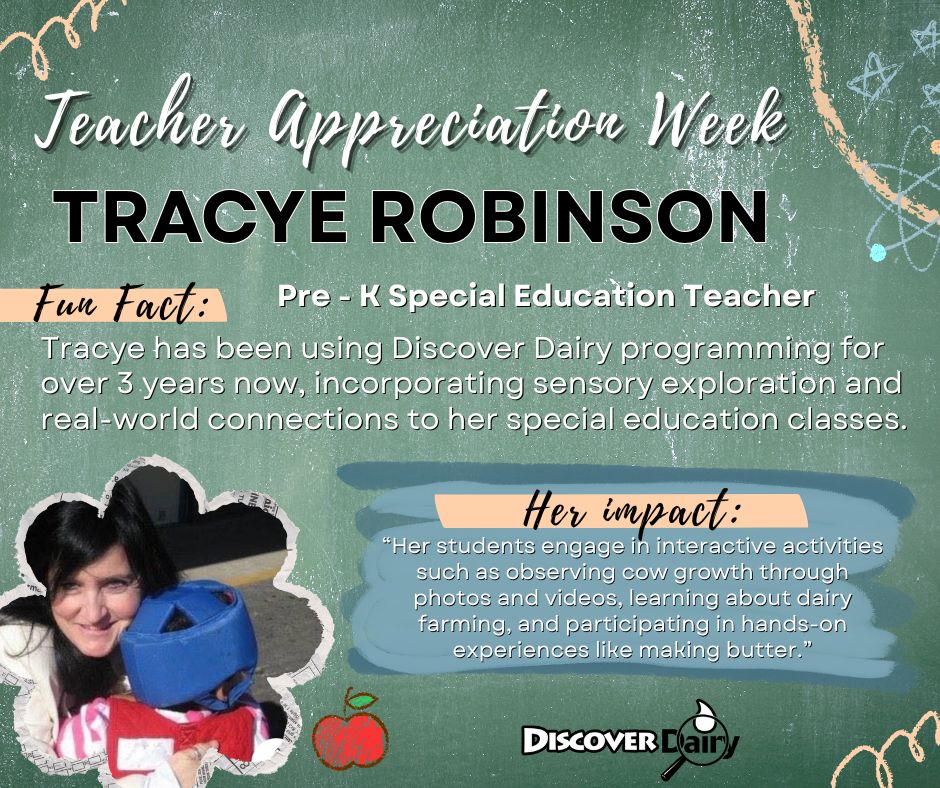
Tracye Robinson is a standout educator in early childhood special education, whose creativity and commitment to her students have made a lasting impact. For the past three years, Tracye has seamlessly integrated the Discover Dairy and Adopt a Cow programs into her PreK classroom, turning them into hands-on, engaging learning experiences that are accessible for all her students.
With a passion for fostering inclusivity and supporting her students’ diverse needs, Tracye creates an environment where learning is not just about academics, but also about developing empathy, responsibility, and curiosity. Through the Adopt a Cow program, her students explore agriculture, science, and social-emotional learning in ways that nurture sensory development, language acquisition, and cognitive skills. Whether it’s making butter, observing cow growth, or engaging with sensory activities tied to farm life, Tracye ensures each student has a meaningful connection to the material.
Tracye also fosters community involvement by sharing the excitement of the program with families through newsletters and home activities. Her innovative approach brings the world of agriculture into the lives of her students, helping them grow in both knowledge and character.
“Tracye’s dedication to making learning accessible and enriching for her students with special needs is a testament to her incredible passion and expertise as an educator. She always finds new ways to bring learning to life!”
Meet Corinne Hooten
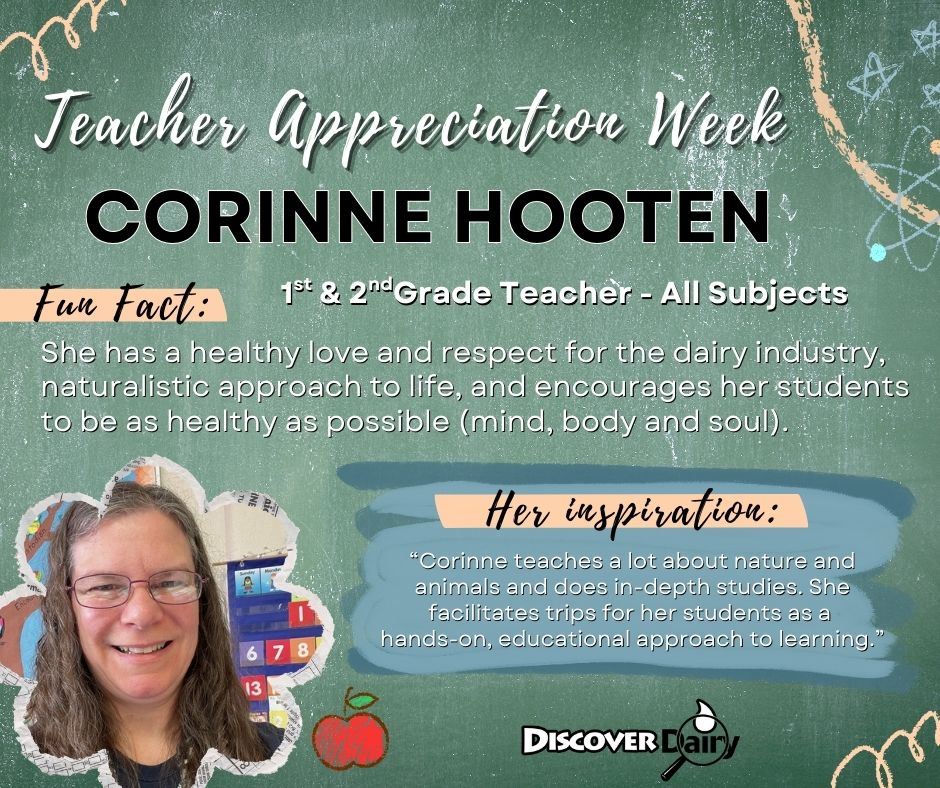
Corinne Hooten is a passionate and dedicated teacher at Bradford Area Christian Academy, where she shapes the minds and hearts of 1st and 2nd grade students. With a deep respect for the dairy industry and a naturalistic approach to life, Corinne encourages her students to embrace healthy habits for the mind, body, and soul.
Her hands-on teaching style makes learning come alive. Corinne takes her students on farm visits, teaches about ecosystems, habitats, and the natural world, and facilitates in-depth studies of animals and their environments. Her commitment to experiential learning inspires her students to explore the world around them and build a connection to nature.
Through her participation in the Discover Dairy and Adopt a Cow programs, Corinne introduces her students to the dairy industry every other year, helping them understand animal care and healthy living. Her students benefit not only from her curriculum but from her unwavering dedication to making learning meaningful and impactful.
“Corinne is an amazing teacher who truly pours her heart into her students, teaching them the importance of a healthy, balanced life and a deep respect for the world around them.”
Meet Callie Thigpen

Callie Thigpen is lighting the way for agricultural education in middle school—and she’s doing it with heart, grit, and incredible impact. As the ONLY middle school agriculture teacher in her county, Callie teaches 6th and 7th grade students core topics like food production, plant and animal care, and soil systems, while helping 8th graders explore careers in agriculture, environmental science, and agribusiness.
Now in her third year of teaching—and her first as a mom—Callie continues to go above and beyond to create a classroom full of energy, discovery, and opportunity. From bringing in live plants and animals to leading students in tractor driving and beef judging competitions, she makes learning tangible and meaningful. Her dedication is inspiring students to consider future careers in ag and helping them build real-world skills they’ll carry for life.
“Callie’s hands-on approach ignites a passion for agriculture in her students. She’s not just teaching lessons—she’s shaping future leaders in the industry.”
Meet Wendy Hamilton
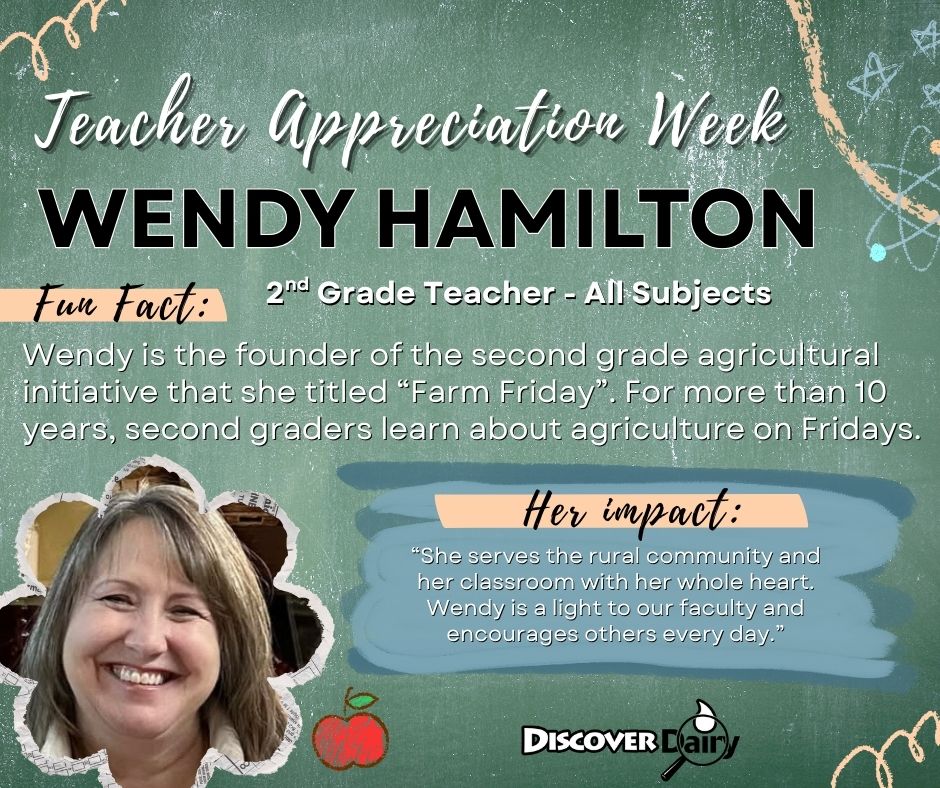
Wendy Hamilton, a 2nd grade teacher at Northern Potter Children’s School, brings her love for agriculture and education together in a way that transforms her classroom and community. With a dairy background and a deep passion for her rural roots, Wendy is the heart behind the school’s beloved Farm Friday program.
For over 10 years, Wendy has led Farm Friday with unwavering dedication—creating lessons, organizing virtual farm tours, inviting local farmers and FFA members into the classroom, and even teaching students about her own family’s maple farm. Each week, second graders explore how the food they eat and the products they use connect to agriculture, building real-world understanding and respect for the farming community.
Wendy’s impact doesn’t stop with her students. She lifts up the entire faculty with her encouragement, kindness, and enthusiasm. Her work reminds everyone that “No Farms, No Food” isn’t just a motto—it’s a mission that begins with education.
“Wendy is committed to making agriculture important because it is important to everyone. Her passion is what makes Farm Fridays so successful and meaningful for our students.”
Happy Earth Day – April 22 – How Dairy Farmers Go Green

Dairy farmers were going green long before it was trending, and they continue to innovate on how they can protect natural resources. From recycling water through multiple uses such as irrigating fields, cleaning barns and cooling milk to reusing sand bedding, discover six ways dairy farmers reduce, reuse and recycle. With the onset of spring, dairy farmers must find the right time to spread manure on cropland as a natural fertilizer, following federal, state and local clean water laws, so nutrients are absorbed by crops, not groundwater.
Age group? All Ages.
Virtual Farm Tours For Every Age Group on April 22

American Dairy Association North East’s Virtual Farm Tours transport you digitally to a real dairy farm with the farmer as your LIVE guide! It’s simple to get started:
- Register at the links below for one tour, or many! You will be emailed your custom link to join. Each tour is unique and LIVE. Even if you can’t join live, you will always be given a link to the recording on YouTube.
- Use their free lesson plans with our tours to engage students while meeting curriculum standards.
- Grab your device of choice the day of and join live. You can use the Zoom Link, Facebook Live Link or YouTube Link sent to you.
In addition to being hosted via Zoom for those joining in the classroom, each tour will be live streamed to Facebook and YouTube so students tuning in from home may participate. Check out their website for more information.
Mercer Vu Farms Virtual Farm Tour Pre-K – Grade 5 | Complimentary Lesson Plans
Tuesday, April 22, 2025, at 10 a.m. EST
REGISTER HERE
Dairy Deep Dive Tour – Mercer Vu Farms
Grades 6-12 | Complimentary Lesson Plans
Tuesday, April 22, 2025, 11:15 a.m. EST
REGISTER HERE
Farmers Celebrate Earth Day Every Day: Free Lessons
The Maine Dairy and Nutrition Council provides a series of 3 fantastic lesson plans to get you and your students ready for earth day! Learn how dairy farmers are environmental stewards of the land and are part of the solution towards a more sustainable world.

Lesson 1: Farming is Elemental
Lesson 2: A Year in the Life of a Farm
Lesson 3: Sustainable Farming Sustains the World
| Check out more of their classroom resources! The Maine Dairy and Nutrition Council works to bring the story of dairy to Mainers – the nutritional benefits, how to use it in the kitchen, the farmers and their practices, the land they conserve, and, of course, the cows we all love so much. This partner supports programming and access to Discover Dairy for students and teachers in Maine. |
Dairy Fun Fact
Did you know? Robots can help with milking, feeding, cleaning and much more on a dairy farm.
Share this fun fact with your students as they learn about dairy technology!

Cow Craft Idea
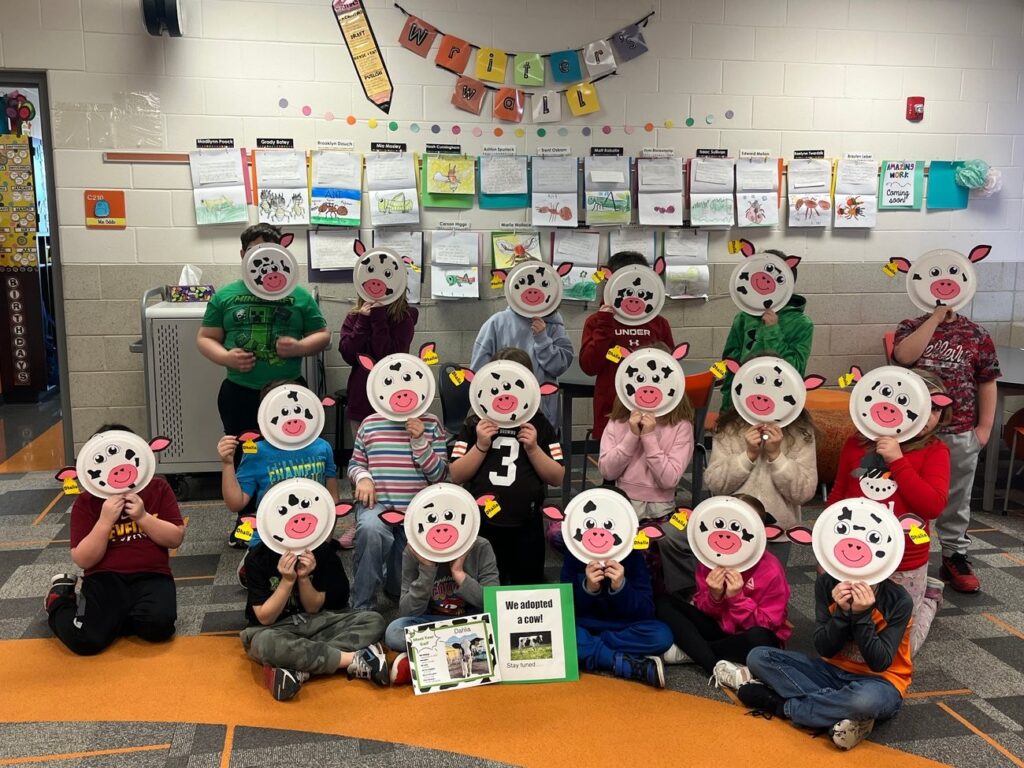
As you wrap up the school year, consider this idea from Kelli in Ohio! Her students created mini versions of their calf, even including an ear tag with her name.
We’d love to see your creativity and share it with others too! Send your photos and stories to us at info@discoverdairy.com.
End-of-Year Activity: Create Your Own Ear Tag Kits

Looking for a final activity to do with your students to commemorate your Adopt A Cow experience? We have just the thing for you!
These Ear Tag Kits will give you and your students time to reflect on the fun filled year with your calf while completing a short decorating craft.
A cow’s ear tag helps dairy farmers identify the cow from the rest of the herd. Students can have their own as a keepsake for their adopted calf. To get a kit of ear tags for your class, complete the preorder form.
What is in the Ear Tag Kit?
- 10 lime green ear tags. Side 1 has the Discover Dairy cow printed on it. Side 2 is blank to customize.
- 10 blank milk splash stickers to stick on the other side of the tag and draw on.
- 1 guided classroom activity plan to complete while decorating the ear tags.
- 1 surprise gift for the teacher!
Estimated Arrival:
You can expect to receive your kit by April 30th! Note: Extra sets of 5 ear tags and milk splash stickers can be added to your order